GREAT TOE PROBLEMS
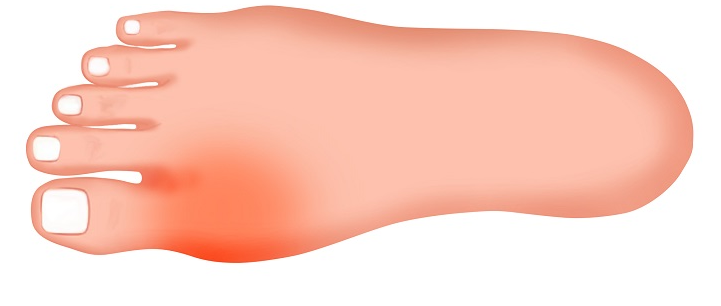
The great toe, the big first digit in your foot, has earned its title. A very important part of foot mechanics, the great toe anchors the foot for power, leverage, and stability in gait mechanics. With great responsibility comes great stress! The structures throughout the great toe are subject to all kinds of acute and chronic problems.
THE MTP Joint of the Great Toe
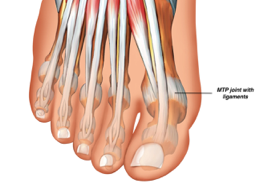

The MTP joint is the main pivot point for the great toe for walking and running. The joint connects the great toe to the foot. This joint takes a lot of abuse and there are several issues that can occur here. The joint basically connects a toe bone (phalanx) to the first foot bone (metatarsal). There are ligaments, which are thick connective tissue segments, that hold the joint together.
WHY DOES MTP PAIN OCCUR?
The MTP will become painful with overloading with too much running, and can also become suddeny injured with an awkward step or twist.. If there are already preexisting problems like structural abnormalities or “wear and tear”, then the MTP joint will be more vulnerable to running injuries.
Here are some common MTP scenarios in runners:
MTP SPRAIN

A sprain occurs when ligaments holding the MTP joint together get stretched or torn because of an awkward step or twist. With running, prolonged repetitive stress could injure the ligaments slowly over time. A sprained MTP will cause pain directly over the joint, often under the foot. Fortunately, most ligament injuries in the MTP joint can heal. However, severe injuries may have swelling and bruising and could require
surgery.
HALLUX LIMITUS
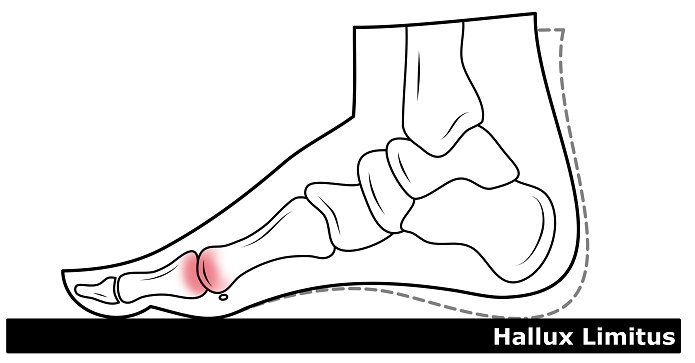
The MTP joint can become stiff, decreasing the motion of the joint. Typically this will limit extension (upward movement) of the great toe. Hallux limitus can occur because of a muscle or bone problem. Muscle tightness can limit movement, but this could improve with foot care and training adjustments. When the bone wears down and limits movement, then there will be permanent limitations in your running mechanics. Hallux limitus can cause pain at the MTP joint or can cause other aches in the foot and leg.
HALLUX RIGIDUS
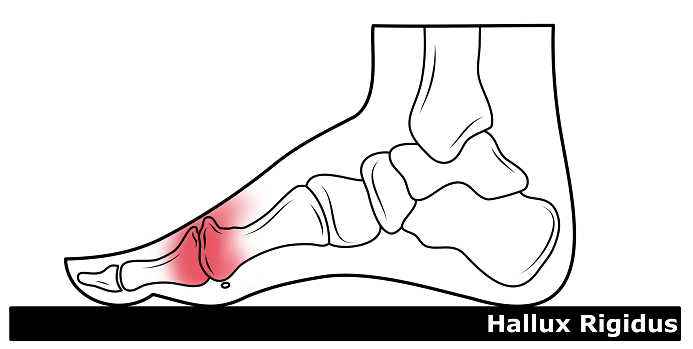
When degenerative “wear and tear” in the MTP worsens, bone spurs form at the top of the joint that create a mechanical block that won’t allow toe extension, and the MTP joint can lose most or all of its function. The rigid joint affects gait and limits running ability. There are 2 problems. With minimal great toe motion, the foot has less leverage to spring forward. Meanwhile, the “wear and tear” reduces the durability of the joint, which affects how much and how far you can run.
OSTEOARTHRITIS OF THE MTP JOINT

General breakdown can occur between the bones in the joint, causing a decrease in cushioning. This leads to a lack of durability that leads to pain with repeated joint loading, especially with running where there is nowhere for the foot to hide. Mechanics with generalized OA in the MTP are affected mostly from pain but there can be nonspecific stiffness in the joint as well.
BUNION (HALLUX VALGUS)
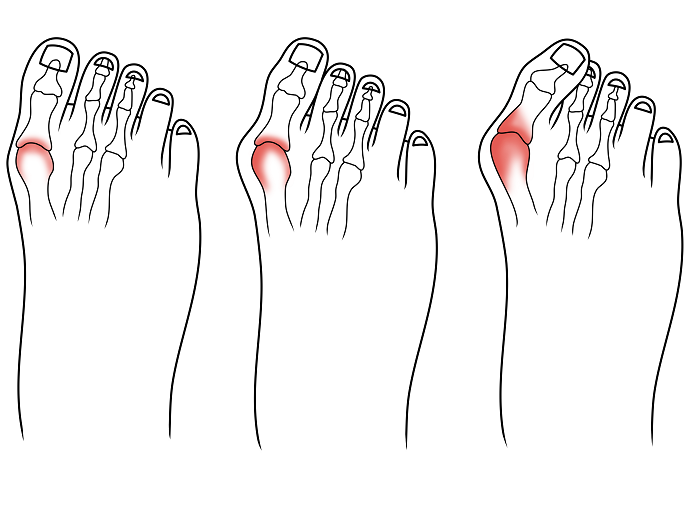
The dreaded bunion is the bane of the athlete. With a bunion, a particular deformity bends the MTP joint sideways. This causes the structure of the foot to change permanently in a way that is terrible for running. The great toe loses its leverage, and the bones rub together and cause pain with repetitive motion. In addition, the bulge that develops on the side of the foot makes it much harder to properly fit into running shoes. Exercise doesn’t necessarily cause bunions, but can definitely make bunions painful and can contribute to long-term “wear and tear”. Runners will tend to feel bunion pain because of the joint deformity causing the bones to rub together. They will also get pain from shoe contact at the side of the foot.
BEWARE!
Pain in the region of the MTP joint can also be a result of a problem in any nearby structure like the overlying muscles/tendons, or the sesamoid bones.
TREATMENT
Generally, the best treatment is to modify all factors that can irritate a damaged MTP joint. Run less, get plenty of rest, and wear a stiff shoe to protect the joint. Ice and anti- inflammatory interventions can relieve the MTP joint if it gets aggravated from your training. For bunions, the bump on the side of the joint may be so prominent that you may have to cut out a “window” on the side of your shoe to alleviate direct pressure. For recurrent MTP pain, especially if the joint is arthritic, always run only on smooth, even ground, and avoid extreme terrain like hills and rough, rocky trails. In serious cases, you may need a specialist to help you modify your existing maximum support shoe with inserts or orthotics. In certain situations, medications, injections, or surgery may be an option for severe persistent pain, but by this point, running may no longer be possible.
SESAMOID PAIN
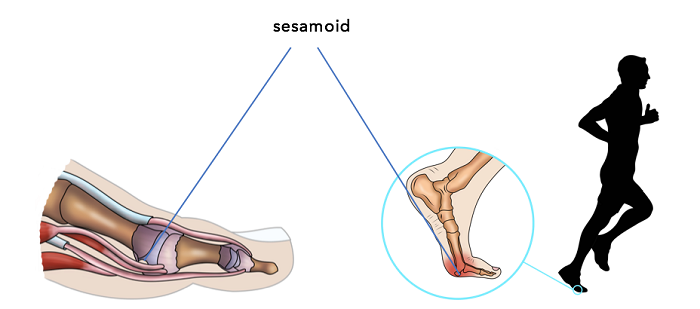
WHAT IS IT?
Two small round SESAMOID bones in the flexor muscles assist in toe flexion (push toe down). The sesamoids or surrounding tissue can develop painful inflammation from running.
WHY DOES IT GET INJURED?
The sesamoids take a lot of punishment with constant ground contact and toe flexion. Poor shoe support and overtraining, especially on hard terrain can further contribute to injury.
WHAT CAN HAPPEN?
Inflammation can develop in the sesamoid bones or in the surrounding flexor tendons. The sesamoid can break.
SYMPTOMS
There is gradual onset of pain and tenderness at the injured sesamoid under the base of the big toe, worse with ground contact. Toe flexion may make the pain worse.
BEWARE
Great toe joint (MTP) pain, toe flexor tendinitis, and plantar fasciitis can cause similar pain. Pain on top of the foot is not sesamoid related.
TREATMENT
The bone and surrounding tissue will need time to heal. Rest is often combined with offloading with a cast, brace, or crutches. Icing and anti-inflammatory diet may help. Sesamoiditis can take days to months to resolve depending on the extent of injury.
GREAT TOE FLEXOR STRAIN
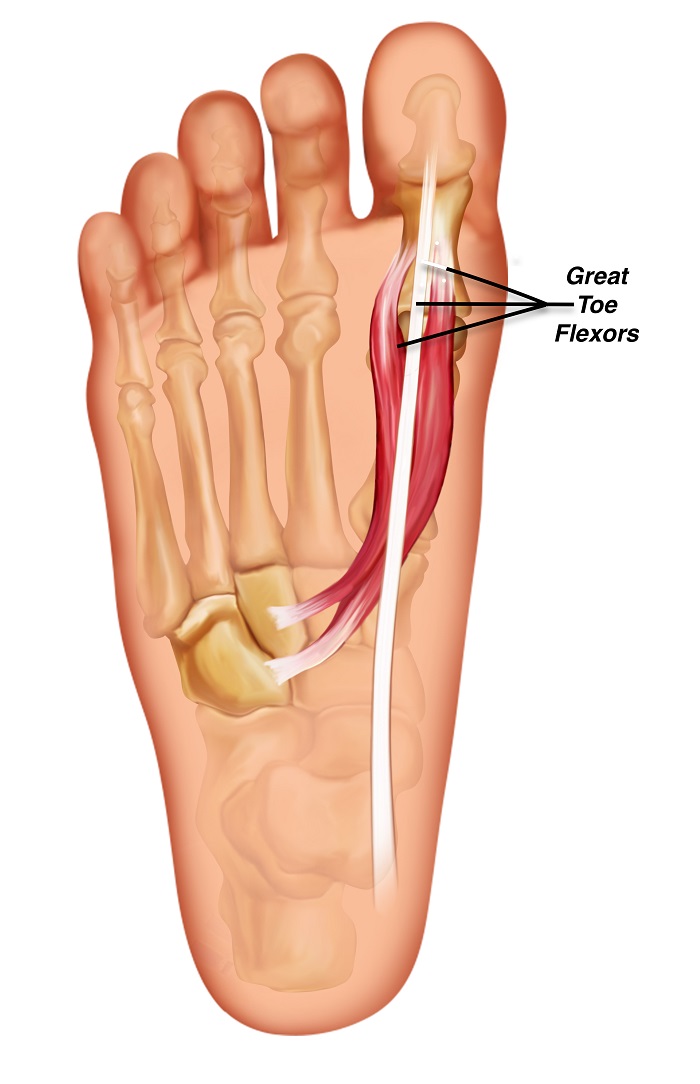
WHAT IS IT?
The flexor muscles flex to push the big toe into the ground for leverage to spring forward with each running step. There are 2 sets of muscles that insert into the great toe.
WHY DOES IT GET INJURED?
The tendon can generally get overworked with high mileage, poor mechanics, bad shoes, rough terrain, and sudden changes in training. Some runners habitually curl their great toe down when they run. Sometimes an awkward step can cause a sudden strain from a twist or overstretching.
SYMPTOMS
Runners will get pain along the bottom of their foot worse with the pushoff phase of gait. The pain can be in the foot or in the toe.
WHAT ELSE COULD IT BE?
Sesamoid pain, MTP joint pain, stress fracture.
BEWARE
Stiffness in the toe may not be from tight muscles, but can be because of arthritis in the MTP toe joint, which can be a difficult problem for runners.
TREATMENT
Proper shoe fit, training modifications, foot stretching, and anti-inflammatory techniques can help resolve this problem. Shoe changes can be very helpful.
GREAT TOE EXTENSOR (EHL) STRAIN
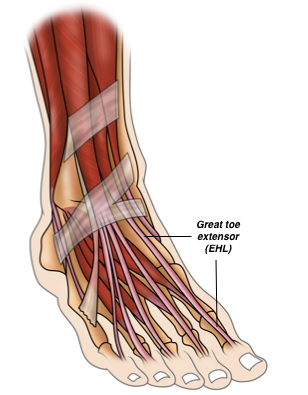
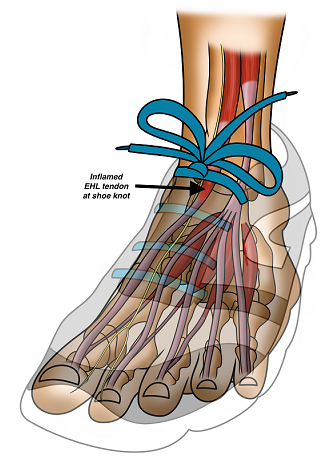
WHAT IS IT?
The extensor hallucis longus (EHL) muscle runs along the top of the foot to extend the big toe (lift it off the ground).
WHY DOES IT GET INJURED?
It could get injured from overuse or poor shoe fit that causes the muscle to work too hard. However, the EHL is very prominent at the level of the lace line where you seems to be most vulnerable from pressure at the lace line where you tie your shoe. The EHL is prominent here and can get “pinched” easily. This is especially true when you don’t tighten your laces evenly from top to bottom.
SYMPTOMS
You will feel an ache on the top of your foot at or near the great toe. Typically, the pain will be at the lace line where you tie your shoes.
TREATMENT
Tighten your laces evenly from top to bottom so you are not pulling hard where the knot sits at the level of the EHL. In the meantime, for soreness, icing can help. If the soreness persists, a shoe change may be needed, and rest or other training modifications should be discussed with your doctor.
RECENT BLOG POST
TAPING YOUR INJURIES!
Taping has long been used by physical therapists and athletic trainers to treat various sports-related musculoskeletal injuries. Kinesiology taping is a modernized method of taping, popularized by its
